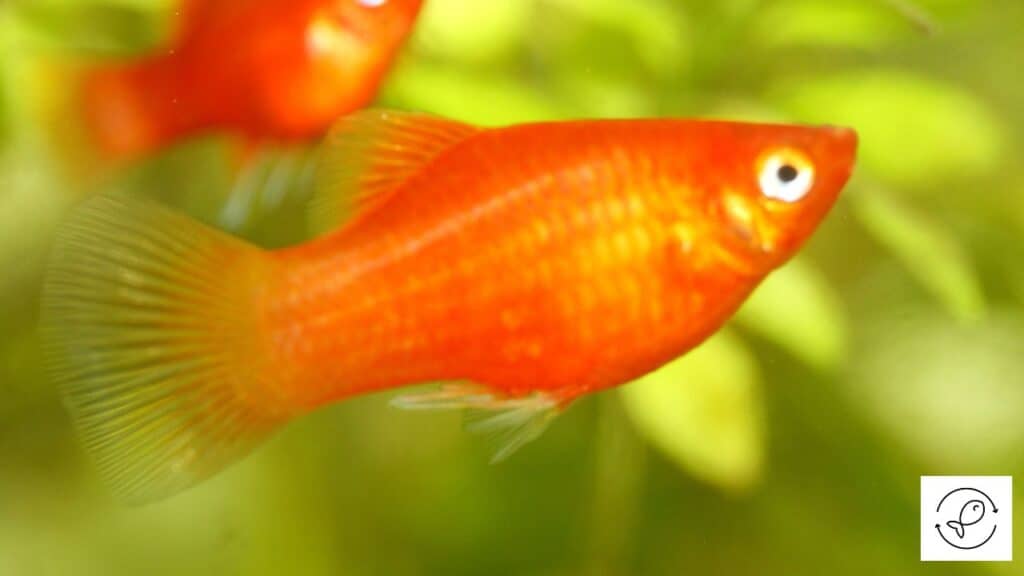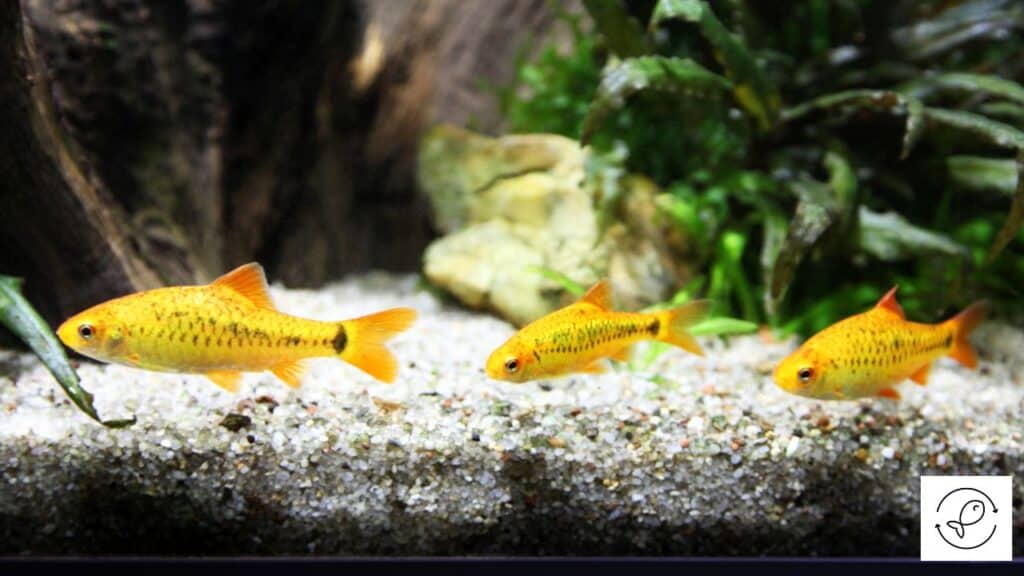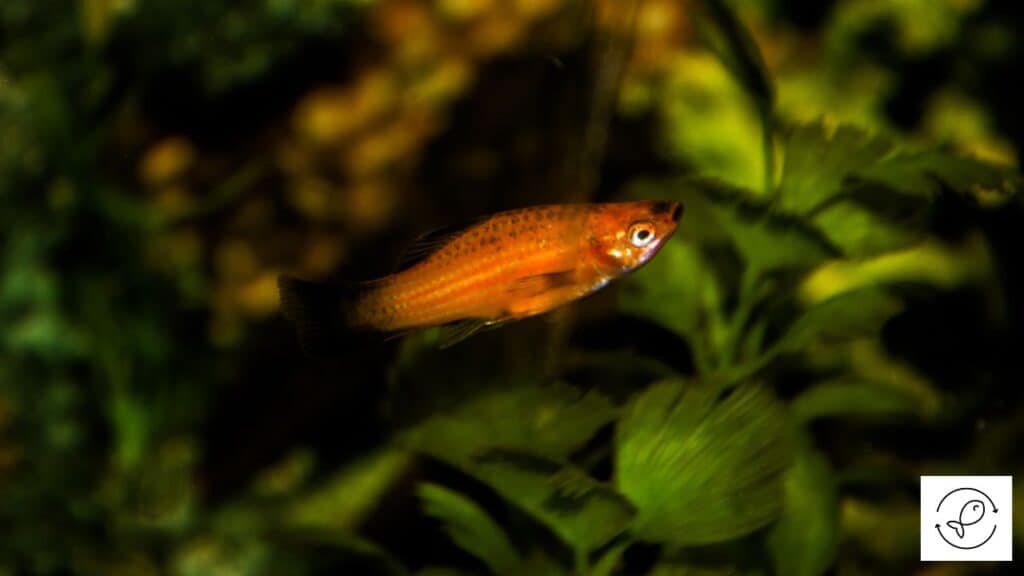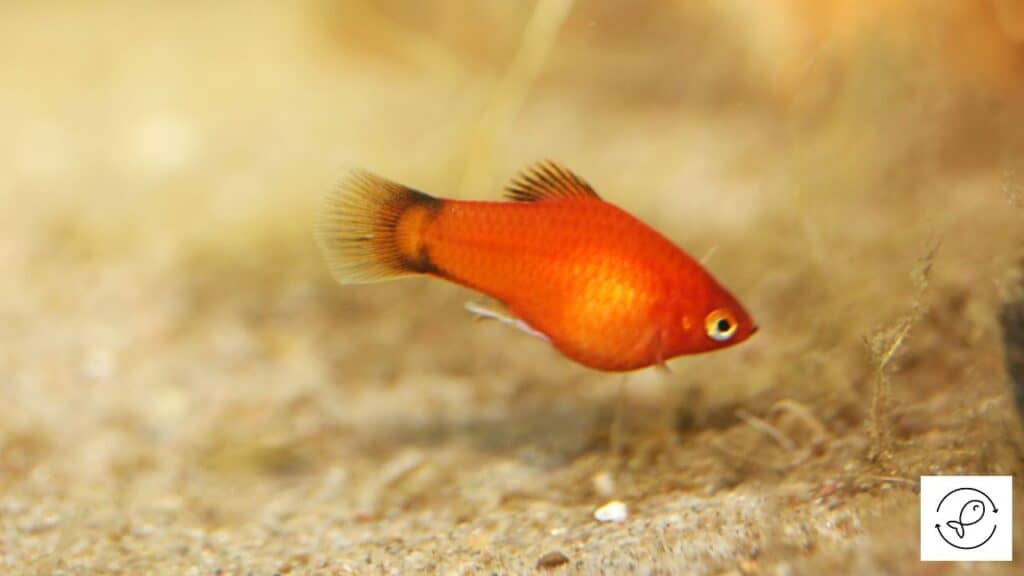Platies are highly sought-after for home aquariums due to their beautiful colors and patterns.
These fish are docile, easy to manage, and prolific breeders. As a result, many aquarists prefer keeping them in their aquariums.
Let’s learn about platies in more detail.
Platy Species Overview
Platies are tropical fish species that inhabit the warm waters of the eastern coast of Central America and southern Mexico.
Wild platies don’t have as vibrant colors as those commonly sold in pet stores.
This fish inhabits shallow river environments with a sandy substrate and clean water where vegetation can flourish easily.
These freshwater fish are an excellent option for novice aquarists because of their relaxed temperament and hardiness.
Appearance

Platies can be found in various colors and patterns.
Wild variants may not be as vibrant as those bred in captivity, which come in a range of spotted patterns or solid colors.
Platies are typically short and stout, with flattened bodies on either side.
This makes it easy for them to move swiftly through the water.
Platies demonstrate gender dimorphism. The best way to determine the gender of platy is by observing its anal fin.
Names of Platy Species
Platies belong to the genus “Xiphophorus” in the family Poeciliidae.
There are currently 21 known platy species. Some of these species are prevalent in the aquarium hobby.
The different species of platies are:
- Black Hamburg platy,
- Bumblebee platy,
- Calico platy,
- Comet platy,
- Dalmatian platy,
- Gold Twin Bar platy,
- Green Lantern platy,
- Hifin platy,
- Malibu Sunset platy,
- Mickey Mouse platy,
- Neon Blue Wag platy,
- Neon Gold Calico platy,
- Panda platy,
- Parrot platy,
- Pintail platy,
- Rainbow platy,
- Salt and Pepper platy,
- Sunset platy,
- Tuxedo platy,
- Variegated platy, and
- Wagtail platy.
Lifespan
In their natural habitat, platies have an average lifespan of 3 to 5 years. Some varieties can live up to 5 years in the wild.
However, the average lifespan of platies is less in captivity compared to their natural environment.
The average lifespan of platies in captivity varies according to the sub-species.
However, they can live up to 2 to 3 years in captivity if provided with optimal living conditions and a well-balanced diet.
Average Size
In the wild, platies grow up to 2.5 inches in length, similar to those bred in captivity.
Female platies are usually bigger than males. They can grow up to 2.5 inches, while male platies grow up to 1.5 inches in length.
These fish are perfect for small tanks due to their compact size. However, you must provide them with a conducive environment.
Platy Tank Setup

Platies thrive when kept in an environment similar to their natural habitat.
Maintaining stable water parameters and creating a balanced ecosystem is essential for their health.
Let’s understand the tank requirements of platies in more detail.
Tank Size
While deciding on the size of the aquarium, consider how many platies you want to keep.
The small size of platies makes them ideal for smaller aquariums.
So a small-sized aquarium of 10 gallons with more horizontal space is adequate for up to five to six platies.
An extra two gallons of water per fish must be added if you introduce more platies into the aquarium.
This will help all the fish to live comfortably.
Tank Equipment and Decorations
Add plants and open spaces in your freshwater tank to re-create the natural environment of platies.
These fish spend most of their time at the top or middle level of the tank.
So you can use either sand or gravel as the substrate in your tank.
Adding caves, rocks, and other decorations to the tank will give your platies more places to hide.
It’s necessary to ensure that the tank lid is secure to prevent platies from jumping out.
These fish should also be kept in tanks with lighting to ensure good health. The lights shouldn’t be too bright.
Given below are the items required in a platies tank:
- Substrate (gravel or sand),
- Aquatic plants like Duckweed, Hornwort, and Java Moss,
- Aquarium Filters,
- Aquarium Heater,
- Moderate aquarium lighting,
- Thermometer,
- pH testing kit, and
- Hiding places like caves, driftwood, rocks, etc.
Maintaining the appropriate pH levels is essential for the well-being and comfort of your fish.
Platy Care

Aquarists often choose platies because of their adaptability to many environments.
However, it’s crucial that you give your platies a nutritious diet and a clean environment.
Diet
In their natural habitat, platies consume algae, vegetation, insects, and tiny crustaceans.
However, these omnivores aren’t fussy eaters and will accept any food offered to them in captivity.
These fish enjoy eating algae and boiled vegetables like lettuce, cucumber, spinach, and zucchini.
To ensure protein intake, you can provide these omnivores with fish flakes, and live and frozen food.
It’s essential to give a nutritious diet for these fish to thrive in captivity.
Some of the live food that you must feed your platies are:
- Brineshrimp,
- Bloodworms,
- Tubifex,
- Daphnia,
- Insect larvae, and
- Small-sized insects.
Feed your platies only a small amount of food once or twice a day to keep them healthy and active.
Water Parameters
In the wild, platies are commonly found in freshwater habitats like rivers, ponds, and marshes.
The precise water requirements depend on the species of platies, but the general guidelines should work for most varieties.
The ideal water parameters for platies are:
Water Temperature: 65°F to 77°F (18°C to 25°C)
Water pH: 7 to 8
Water Hardness (dGH): 10 to 28
Tank Maintenance
Platies are resilient and can withstand various conditions. However, it’s always better to keep their tank clean.
Remove any leftover food from the tank immediately to keep the water clean.
Also, perform regular water changes to ensure that your aquarium stays in good condition.
To maintain stable water quality, perform a 25% to 30% water change once every two weeks.
Cleaning your aquarium filter, substrate, and decorations regularly will keep them in optimal condition.
An algae scrubber, water conditioner, and gravel vacuum can make aquarium maintenance easier and ensure proper hygiene.
It’s essential to test the water parameters of your aquarium regularly by using a test kit.
Common Diseases
Platies are hardies but aren’t entirely immune. They are susceptible to common freshwater diseases.
So it’s essential to keep an eye out for any issues that may result from poor water quality.
Given below are some of the common diseases that can affect platies:
- Fin rot,
- Ich,
- Velvet,
- Bacterial infections, and
- Parasitic infections.
For the optimal health of your aquarium, you must change the water regularly and maintain adequate tank hygiene.
Platy’s Behavior and Temperament
Platies are peaceful and social fish species. These fish prefer to live in groups of six to eight.
They aren’t schooling fish, but they enjoy the company of other platies.
Platies are ideal for community aquariums as they are peaceful and get along well with other fish species.
These fish often swim near the aquarium’s surface or the mid-level.
Platies rarely display any aggression.
However, male platies can display aggression toward other males during the mating period.
Platy’s Tankmates

Aquarists often keep platies in community tanks due to their vibrant colors and peaceful nature.
However, platies can exhibit aggression when kept with other male platies.
So it’s best to keep a single male platy with multiple female platies.
Platies should be housed with other non-aggressive species in a big tank to make them feel secure and comfortable.
It’s recommended to have at least four to five platies in your aquarium before introducing other fish species.
Some of the compatible tankmates for platies are:
- Bristlenose Plecos,
- Cory catfish,
- Guppies,
- Gouramis,
- Mollies,
- Tetras,
- Rainbowfish,
- Swordtails,
- Algae-eating crabs,
- Shrimp, and
- Snails.
Given below are some of the fish species that you should avoid housing with platies:
Keeping platies and goldfish together is not advisable due to their different water temperature requirements.
Bettas are aggressive and will display hostile behavior toward any platies that enter their territory.
So it’s ideal to choose tankmates for platies that are compatible with them. This will ensure a peaceful aquarium environment.
Platy Breeding
Platies are easy to breed as they are livebearers and reproduce quickly in a suitable tank environment.
These fish can breed in community aquariums that contain thick vegetation.
However, having a dedicated breeding tank for your platies will help the fry stay safe.
The tank should be a minimum of 10 gallons in capacity and include plants that provide cover for the young ones.
Introduce the male and female platies into the breeding tank and provide them with protein-rich food to trigger spawning.
Female platy can get pregnant quickly. After a gestation period of 24 to 30 days, she will give birth to around 80 baby platies.
Once the female platy has given birth to all the young ones, the parents should be removed from the tank immediately.
You can give the newborn fry a diet of infusoria or powdered fish food.
Once the fry begin to grow, feed them baby brine shrimp until they can eat regular food.

